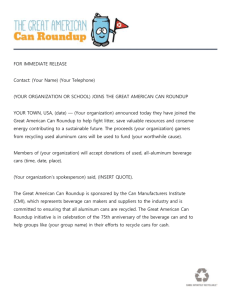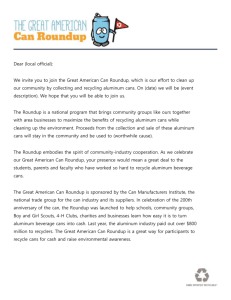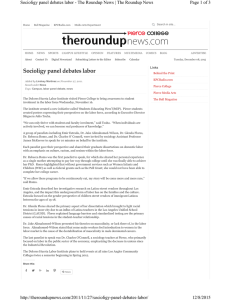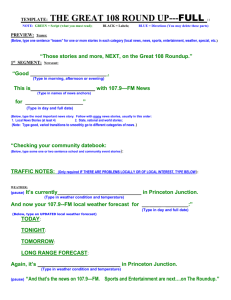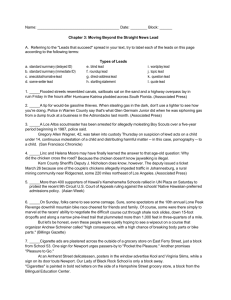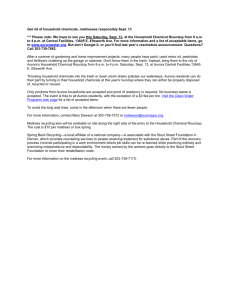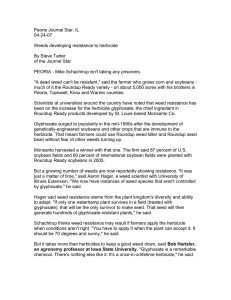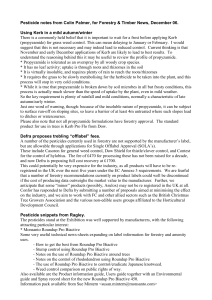Tech Tips Recreation Using Roundup to Treat Trail Surface Vegetation Technology &
advertisement
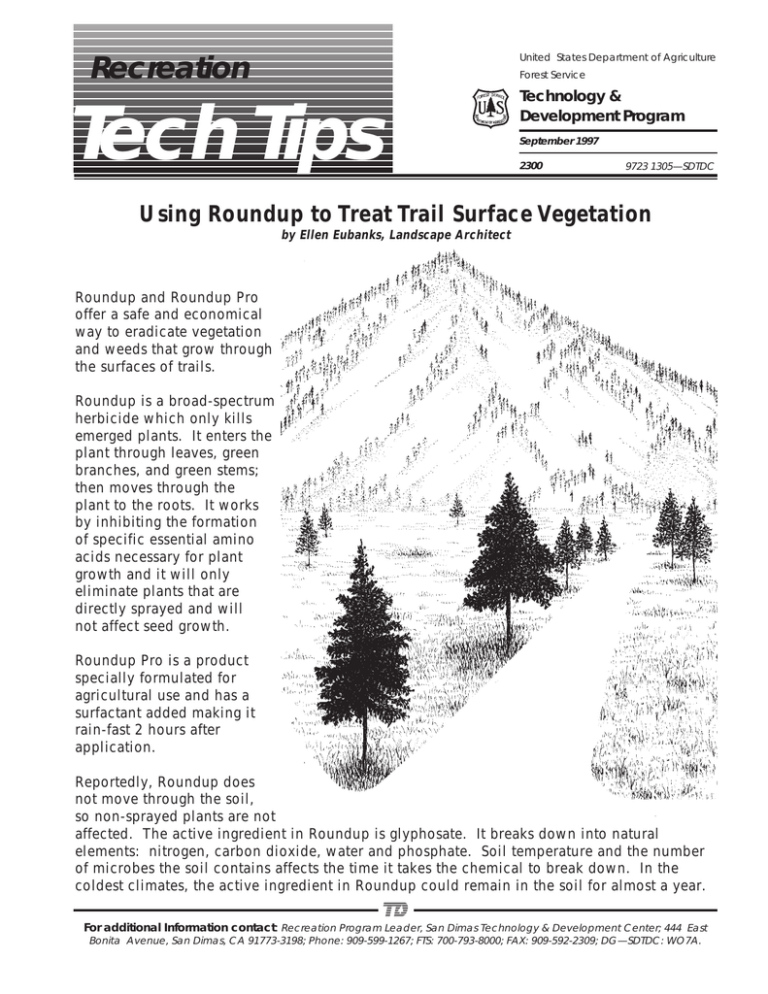
United States Department of Agriculture Recreation Forest Service Tech Tips Technology & Development Program September 1997 8/12 Avant Garde Regular Italic 2300 9723 1305—SDTDC Using Roundup to Treat Trail Surface Vegetation by Ellen Eubanks, Landscape Architect Roundup and Roundup Pro offer a safe and economical way to eradicate vegetation and weeds that grow through the surfaces of trails. Roundup is a broad-spectrum herbicide which only kills emerged plants. It enters the plant through leaves, green branches, and green stems; then moves through the plant to the roots. It works by inhibiting the formation of specific essential amino acids necessary for plant growth and it will only eliminate plants that are directly sprayed and will not affect seed growth. Roundup Pro is a product specially formulated for agricultural use and has a surfactant added making it rain-fast 2 hours after application. Reportedly, Roundup does not move through the soil, so non-sprayed plants are not affected. The active ingredient in Roundup is glyphosate. It breaks down into natural elements: nitrogen, carbon dioxide, water and phosphate. Soil temperature and the number of microbes the soil contains affects the time it takes the chemical to break down. In the coldest climates, the active ingredient in Roundup could remain in the soil for almost a year. For additional Information contact: Recreation Program Leader, San Dimas Technology & Development Center; 444 East Bonita Avenue, San Dimas, CA 91773-3198; Phone: 909-599-1267; FTS: 700-793-8000; FAX: 909-592-2309; DG—SDTDC: WO7A. 1 PROPER USE Label instructions are good but here are some tips: • Temperature—use when ambient air temperature is between 60 - 85 degrees F. • Do not use if rain is expected, or if foliage is wet. • Do not water treated areas for at least 6 hours after treatment. • Allow seven days for plant to die. • Recreational use may resume in a treated area after Roundup has completely dried (usually six hours— although in some climates, drying may take up to 24 hours). • Do not use in windy conditions or on water. • In cool, dark or dry climates the effects of treatment may take longer than a week because plant growth rates are slowed and the chemical requires more time to act and the plant to die. PRECAUTIONS Long sleeved shirts, long pants, shoes and socks should always be worn during application. Gloves should be worn if treatment lasts longer than 30 minutes. Eyes & Face Protection Although not required, it is recommended that eye protection, chemical goggles, be worn during application. If the chemical gets into the eyes, rinse with water. Skin Irritation Generally, Roundup will not irritate the skin. However, hands and other contacted skin should be washed with soap and water after handling the product. Respiratory Precautions If spraying a large area and a mist or vapor field may develop, it is suggested that a full face respirator equipped with purifying elements for protection against organic vapor and dust/mist be used. Use cartridges with 2 NIOSH/MSHA approval number TC-23C or canister with NIOSH/MSHA approval number TC-14G. The use of the full face piece replaces the need for chemical goggles. Respiratory protection programs must comply with 29 CFR 1910.13. STORAGE Roundup will not burn, is not volatile, and does not require special ventilation. However, it should be: • Kept in a secure locked storage area. • Kept in its original container. • Only mixed, applied, and stored in stainless steel, aluminum, fiberglass, or plastic containers. • Do not mix, apply, or store in galvanized or unlined steel containers (except stainless steel). • The product has a storage/use life of five years; do not freeze. WILDLIFE EFFECTS The main ingredient in Roundup is glyphosate. Laboratory test have shown this chemical to be poorly absorbed if ingested. Negligible residues have been reported in wild animals such as voles, chipmunks, hares and moose after feeding in treated areas. Studies also indicate that glyphosate does not accumulate in edible portions of fish and marine organisms. Glyphosate does not bioaccumulate in the food chain. The Environmental Protection Agency (EPA) concluded that Roundup is only slightly toxic to birds and almost non-toxic to fish, aquatic invertebrates and honey bees. In addition, the EPA has concluded that endangered land or water organisms are not affected from the use of the chemical. DISPOSAL CONSIDERATIONS Follow label instructions when disposing of the product. Do not reuse the empty container. It should be thoroughly rinsed and discarded into the trash. HEALTH HAZARDS The EPA regulates all herbicides and requires specific labeling according to perceived risk. Roundup carries a “Caution” label—the least toxic rating for toxic chemicals. Laboratory tests indicate that Roundup is not carcinogenic, does not affect the nervous system, does not cause birth defects, and does not cause genetic mutations. Toxicology studies indicate that eye and skin contact should be avoided. Eyes should be rinsed if exposure occurs and skin and clothing should be washed with soap and water if contact occurs. MORE INFORMATION For more information on the use of Roundup and other herbicides in your Region, consult: The Forest Service Manual for current policies on integrated pest control, 2150. CFR 40, part 270, permitting; and part 710, reporting requirements. For additional information on either product contact: Roundup Information (800) 225-2883 or http://www.roundup.com Roundup Pro (800) 332-3111 Information for the preparation of this article was provided by both the Solaris Group, Consumer Affairs, a division of Monsanto Company and the Industrial Turf and Ornamental Group which is a division of Monsanto Company. Roundup is a registered trademark of Monsanto. The Forest Service, U.S. Department of Agriculture has developed this information for the guidance of its employees, its contractors, and its cooperating Federal and state agencies, and is not responsible for the interpretation or use of this information by anyone except its own employees. The use of trade, firm, or corporation names in this publication if for the information and convenience of the reader and does not constitute an endorsement by the U.S. Department of Agriculture of any product or service to the exclusion of others that may be suitable. 3 USDA Forest Service San Dimas Technology & Development Center 444 E. Bonita Ave. San Dimas, CA 91773 4
